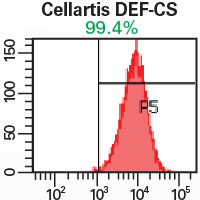Cell morphology in the DEF-CS system
One advantage of the DEF-CS system is the unique potential to culture human iPS cells as a single, homogenous monolayer of undifferentiated cells. Because of this, human iPS cells grown in DEF-CS will look very different from those grown with traditional aggregate culture methods. Notably, there will be a larger cytoplasm-to-nucleus ratio, and cells at lower densities will exhibit a morphology that would otherwise indicate differentiation. However, despite this appearance, human iPS cells grown in DEF-CS media retain their pluripotency and are not differentiated. For reference, the image below depicts the expected morphologies of freshly passaged human iPS cells cultured for five days in either the DEF-CS system, on feeder cells, in mTeSR 1 medium (STEMCELL Technologies), or in Essential 8 Medium (E8; Life Technologies).

Observing cells grown in the DEF-CS system
When initially transferring iPS cells to this system, some cell characteristics might be different from previously used culture systems. The DEF-CS system utilizes single-cell passaging, and therefore the morphology of cells cultured in the DEF-CS system differs from that of cells cultured in systems using aggregate passaging methods. Second, newly passaged cells tend to spread out. However, when proliferating, the cells get denser, and the typical undifferentiated stem cell morphology (i.e., high nucleus-to-cytoplasm ratio, defined borders, and prominent nucleoli) appears. The images below show a human iPS cell line cultured in the DEF-CS system. A cell density of 5 x 104 cells/cm2 corresponds to newly passaged cells, while the higher cell densities are after several days in culture.

Transferring iPS cells to the DEF-CS system
Cells grown in other culture systems
Undifferentiated human iPS cells maintained in other culture systems can be readily transferred to the DEF-CS system. It takes 2–5 passages to adapt a cell line to the DEF-CS system. The standard DEF-CS culture protocol should be followed, although some modifications may increase the success of transfer:
- The cells may benefit from a higher concentration of DEF-CS COAT-1 (coating substance). Use a dilution of 1:10 or 1:5 during the first passage to provide extra support during the transfer process.
- A higher seeding density for the first passage (e.g., 8.0 x 104 cells/cm2) can also be beneficial to the cells.
- Newly transferred cells might initially grow at a slightly slower rate. A suitable passage interval might, therefore, be between 3 and 7 days for the first passages. The cells are ready for passage when they have acquired the morphology in the images above (see 1.5 x 105 cells/cm2 and 2.0 x 105 cells/cm2). Even if the cells are sparse after 7 days in culture, passaging is still recommended.
Fresh iPS cell cultures
Fresh cultures can be transferred to the DEF-CS system at passage. The cells should be dissociated according to the protocol of the previous system and seeded as single cells or aggregates according to the DEF-CS protocol using a 1:1 split ratio.
Frozen iPS cells
Cryopreserved cells can be thawed directly into the DEF-CS system.
Learn more about the DEF-CS system »







